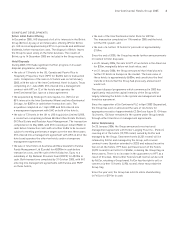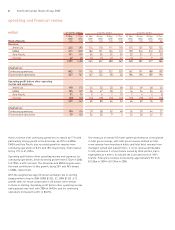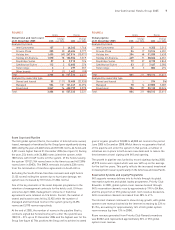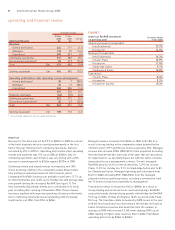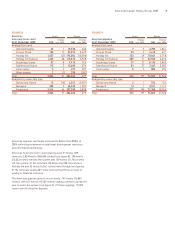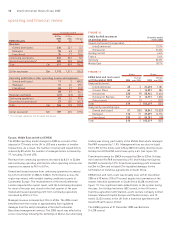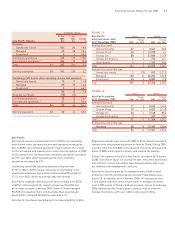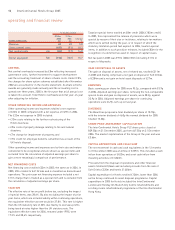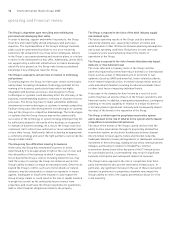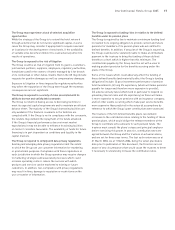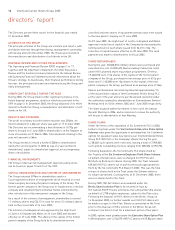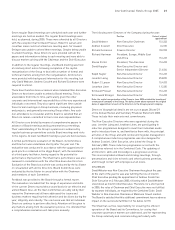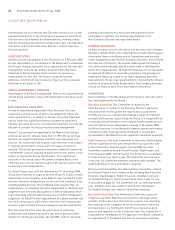Holiday Inn 2005 Annual Report Download - page 15
Download and view the complete annual report
Please find page 15 of the 2005 Holiday Inn annual report below. You can navigate through the pages in the report by either clicking on the pages listed below, or by using the keyword search tool below to find specific information within the annual report.
TREASURY MANAGEMENT
Treasury policy is to manage financial risks that arise in relation to
underlying business needs. The activities of the treasury function
are carried out in accordance with Board approved policies and are
subject to regular audit. The treasury function does not operate as
a profit centre.
Treasury seeks to reduce the financial risk of the Group and
ensures that there is sufficient liquidity to meet all foreseeable
cash needs. One of the primary objectives of the treasury risk
management policy is to mitigate the adverse impact of
movements in interest rates and foreign exchange rates.
Movements in foreign exchange rates, particularly the US dollar
and euro, can affect the Group’s reported profit, net assets and
interest cover. To hedge this translation exposure as far as is
reasonably practical, borrowings are taken out in foreign currencies
(either directly or via currency swaps), which broadly match those
in which the Group’s major net assets are denominated. A general
weakening of the US dollar (specifically a one cent rise in the
sterling:US dollar rate) would have reduced the Group’s profit
before tax by an estimated £1m.
Foreign exchange transaction exposure is managed by the forward
purchase or sale of foreign currencies or the use of currency
options. Most significant exposures of the Group are in currencies
that are freely convertible.
Interest rate exposure is managed within parameters that stipulate
that fixed rate borrowings should normally account for no less than
25%, and no more than 75%, of net borrowings for each major
currency. This is achieved through the use of interest rate swaps
and options and forward rate agreements.
Based on the year end net debt position, and given the
underlying maturity profile of investments, borrowings and
hedging instruments at that date, a one percentage point rise in
US dollar interest rates would increase the net interest charge
by approximately £1m whilst a one percentage point rise in
euro interest rates would increase the net interest charge
by approximately £4m.
CAPITAL STRUCTURE AND LIQUIDITY MANAGEMENT
Net debt at 31 December 2005 of £88m (see figure 14) was
considerably lower than the average debt in the year (£700m) due
to the receipt of funds from hotel sales and the Britvic IPO in the
last three months of the year. The level of borrowings fluctuated
throughout 2005 with the timing of receipts of disposal proceeds
and returns to shareholders. Gearing (net debt expressed as a
percentage of shareholders’ equity) at 31 December 2005 was 8%.
FIGURE 14
31 Dec 31 Dec
2005 2004
Net debt £m £m
Borrowings:
Sterling –247
US Dollar 220 335
Euro 488 799
Australian Dollar –86
Hong Kong Dollar 71 69
Other –2
Cash and cash equivalents (686) (422)
Less fair value of currency swaps (net) (5) –
Total 88 1,116
Note: all shown after the effect of currency swaps.
FIGURE 15
31 Dec 31 Dec
2005 2004
Facilities £m £m
Committed 1,163 1,697
Uncommitted 14 64
Total 1,177 1,761
Medium and long-term borrowing requirements at 31 December
2005 were met through a £1,100m syndicated bank facility which
matures in November 2009. Short-term borrowing requirements
were principally met from drawings under committed and
uncommitted bilateral bank facilities. At the year end, the Group
had £751m of committed facilities available for drawing.
The syndicated bank facility of the Group contains two financial
covenants, interest cover and net debt/Earnings before Interest,
Tax, Depreciation and Amortisation (EBITDA). The Group is in
compliance with both covenants neither of which is expected to
represent a material restriction on funding or investment policy
in the foreseeable future.
InterContinental Hotels Group 2005 13


